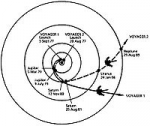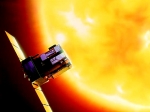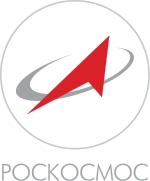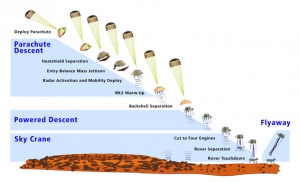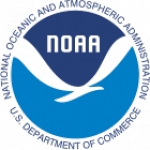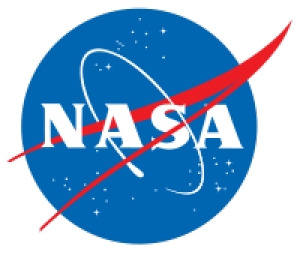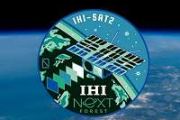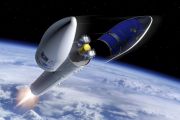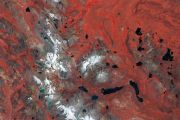Displaying items by tag: science
Voyager program
The Voyager program is a U.S program that launched two unmanned space missions, scientific probes Voyager 1 and Voyager 2. They were launched in 1977 to take advantage of a favorable planetary alignment of the late 1970s.
Although officially designated to study just Jupiter and Saturn, the probes were able to continue their mission into the outer solar system, and are as of December 2011 on course to exit the solar system. These probes were built at JPL and were funded by NASA. Voyager 1 is currently the farthest human-made object from Earth.
Both missions have gathered large amounts of data about the gas giants of the solar system, of which little was previously known. In addition, the spacecraft trajectories have been used to place limits on the existence of a hypothetical trans-Plutonian Planet X.
SOHO (mission & spacecraft)
The Solar and Heliospheric Observatory (SOHO) mission purpose is to study the Sun from a point of gravitational balance.
The SOHO spacecraft has been built by a European industrial consortium led by Matra Marconi Space (now Astrium) that was launched on a Lockheed MartinAtlas IIAS launch vehicle on December 2, 1995 to study the Sun, and has discovered over 2100 comets. It began normal operations in May 1996.
It is a joint project of international cooperation between the European Space Agency (ESA) and NASA. Originally planned as a two-year mission,SOHO currently continues to operate after over fifteen years in space. In October 2009, a mission extension lasting until December 2012 was approved.
In addition to its scientific mission, it is currently the main source of near-real time solar data for space weather prediction. Along with the GGS Wind and Advanced Composition Explorer (ACE),SOHO is one of three spacecraft currently in the vicinity of the Earth-Sun L1 point, a point of gravitational balance located approximately 0.99 astronomical unit (AU)s from the Sun and 0.01 AU from the Earth. In addition to its scientific contributions, SOHO is distinguished by being the first three-axis-stabilized spacecraft to use its reaction wheels as a kind of virtual gyroscope; the technique was adopted after an on-board emergency in 1998 that nearly resulted in the loss of the spacecraft.
Roscosmos
The Russian Federal Space Agency (Russian: Федеральное космическое агентство России Federal'noye kosmicheskoye agentstvo Rossii), commonly called Roscosmos (Роскосмос Roskosmos) and abbreviated as FKA (ФКА) and RKA (РКА), is the government agency responsible for the Russian space science program and general aerospace research. It was previously the Russian Aviation and Space Agency (Russian: Российское авиационно-космическое агентство Rossiyskoe aviatsionno-kosmicheskoe agentsvo, commonly known as "Rosaviakosmos").
Headquarters of Roscosmos are located in Moscow.
Main Mission Control space flight operations center is located in a nearby city of Korolev.
Cosmonauts Training Centre (GCTC) is in Star City.
Launch facilities used are Baikonur Cosmodrome in Kazakhstan(with most launches taking place there, both manned and unmanned) and Plesetsk Cosmodrome in northern Russia used primarily for unmanned flights of military designations.
The MSL mission (Mars Science Laboratory)
The Mars Science Laboratory (MSL) is a National Aeronautics and Space Administration (NASA) mission with the aim to land and operate a rover named Curiosity on the surface of Mars.
The MSL was launched November 26, 2011 at 10:02 am EST and will land on Mars at Gale Craterbetween August 6 and August 20, 2012. It will attempt to perform the first-ever precision landing on Mars. The rover Curiosity will help assess Mars' habitability, that is, whether Mars is, or ever was an environment able to support microbial life. It will also analyze samples scooped up from the soil and drilled powders from rocks.
Serco Group plc
Serco is an international service company in markets as diverse as defence, transport, civil government, science, ...
Serco Group plc is a company registered in England and Wales.
ESA - ESTEC (European Space Agency)
The European Space Research and Technology Centre (ESTEC) is the European Space Agency's main technology development and test centre for spacecraft and space technology. It is situated in Noordwijk, South Holland, in the Netherlands.
At ESTEC, about 2500 engineers, technicians and scientists work hands-on with mission design, spacecraft and space technology.
ESTEC provides extensive testing facilities to verify the proper operation of spacecraft, such as the Large Space Simulator (LSS), acoustic and electromagnetic testing bays, multi-axis vibration tables and the ESA Propulsion Laboratory (EPL). Prior to the launch of almost all equipment that ESA launches is tested in some degree at ESTEC.
NOAA
NASA - National Aeronautics and Space Administration
The National Aeronautics and Space Administration (NASA) is the agency of the United States government that is responsible for the nation's civilian space program and for aeronautics and aerospace research.
The National Aeronautics and Space Administration is America’s civil space program and the global leader in space exploration. The agency has a diverse workforce of just under 18,000 civil servants, and works with many more U.S. contractors, academia, and international and commercial partners to explore, discover, and expand knowledge for the benefit of humanity. With an annual budget of $23.2 billion in Fiscal Year 2021, which is less than 0.5% of the overall U.S. federal budget, NASA supports more than 312,000 jobs across the United States, generating more than $64.3 billion in total economic output (Fiscal Year 2019).
At its 20 centers and facilities across the country – and the only National Laboratory in space – NASA studies Earth, including its climate, our Sun, and our solar system and beyond. We conduct research, testing, and development to advance aeronautics, including electric propulsion and supersonic flight. We develop and fund space technologies that will enable future exploration and benefit life on Earth.
NASA also leads a Moon to Mars exploration approach, which includes working with U.S. industry, international partners, and academia to develop new technology, and send science research and soon humans to explore the Moon on Artemis missions that will help prepare for human exploration of the Red Planet. In addition to those major missions, the agency shares what it learns so that its information can make life better for people worldwide. For example, companies use NASA discoveries and technologies to create new products for the public. To ensure future success for the agency and the nation, NASA also supports education efforts in STEM with an emphasis on increasing diversity in our future workforce.

